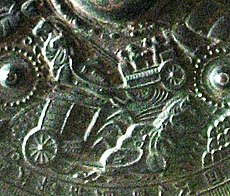This is an old revision of this page, as edited by Per Honor et Gloria (talk | contribs) at 11:46, 9 April 2005 (→Introduction of Buddhism: Haniwa House). The present address (URL) is a permanent link to this revision, which may differ significantly from the current revision.
Revision as of 11:46, 9 April 2005 by Per Honor et Gloria (talk | contribs) (→Introduction of Buddhism: Haniwa House)(diff) ← Previous revision | Latest revision (diff) | Newer revision → (diff)| Part of a series on the | ||||||||||||||||||||||||||||||||
| History of Japan | ||||||||||||||||||||||||||||||||
|---|---|---|---|---|---|---|---|---|---|---|---|---|---|---|---|---|---|---|---|---|---|---|---|---|---|---|---|---|---|---|---|---|
 | ||||||||||||||||||||||||||||||||
Periods
|
||||||||||||||||||||||||||||||||
| Topics | ||||||||||||||||||||||||||||||||
Kofun (古墳) is an era in the history of Japan from around A.D. 250 to A.D.538. A kofun is any tomb (tumulus) of this kind.
Kofun tombs

The Kofun period (ca. A.D. 250- 538) takes its name, which means old tomb (古墳 kofun) from the culture's rich funerary rituals and distinctive earthen mounds. The mounds contained large stone burial chambers. Some are surrounded by moats.

By the late Kofun period, the distinctive burial chambers, originally used by the ruling elite, also were built for commoners.
Kofun came in many shapes, with round and square being the simplest. A distinct style is the keyhole (zempō kōen) kofun, with its square front and round back. Many kofun were natural hills, which might have been sculpted to their final shape. Kofun range in size from several meters to over 400 meters in length.
The biggest kofun are believed to be the tombs of emperors like Ojin and Nintoku. Kofun are also classified according to whether the entrance to the stone burial chamber is vertical (tate-ana) or horizontal (yoko-ana).
Kofun society

During the Kofun period, a highly aristocratic society with militaristic rulers developed. Its cavalry wore armor, carried swords and other weapons, and used advanced military methods like those of Northeast Asia. Evidence of these advances is seen in funerary figures (called haniwa; literally, clay rings), found in thousands of kofun scattered throughout Japan. The most important of the haniwa were found in southern Honshu--especially the Kinai region around Nara--and northern Kyushu. Haniwa grave offerings were made in numerous forms, such as horses, chickens, birds, fans, fish, houses, weapons, shields, sunshades, pillows, and male and female humans. Another funerary piece, the magatama, became one of the symbols of the power of the imperial house. Much of the material culture of the Kofun period is barely distinguishable from those of the contemperaneous Southern Korean Peninsula, demonstrating that at this time Japan was in close political and economic contact with continental Asia through Korea.

The Kofun period was a critical stage in Japan's evolution toward a more cohesive and recognized state. This society was most developed in the Kinai Region and the easternmost part of the Inland Sea (Seto Naikai). Japan's rulers of the time even petitioned the Chinese court for confirmation of royal titles.

The Yamato polity, which emerged by the late 5th century, was distinguished by powerful great clans or extended families, including their dependents. Each clan was headed by a patriarch who performed sacred rites to the clan's kami to ensure the long-term welfare of the clan. Clan members were the aristocracy, and the kingly line that controlled the Yamato court was at its pinnacle. The Kofun Period of Japanese culture is also sometimes called the Yamato Period by some Western Scholars, since this local Chieftainship eventually rose up to become the Imperial Dynasty at the end of the Kofun Period. Japanese archaeologists find this a little predeterministic and emphasise the fact that in the early half of the Kofun Period other regional Chieftainships, such as Kibi, near modern day Okayama, were in close contention for the crown.
Introduction of Buddhism

More exchange occurred between Japan and the continent of Asia late in the Kofun period. Buddhism was introduced from Korea, probably in A.D. 538, exposing Japan to a new body of religious doctrine. The Soga, a Japanese court family that rose to prominence with the accession of the Emperor Kimmei about A.D. 531, favored the adoption of Buddhism and of governmental and cultural models based on Chinese Confucianism. But some at the Yamato court--such as the Nakatomi (later known as Fujiwara) family, which was responsible for performing Shinto rituals at court, and the Mononobe, a military clan--were set on maintaining their prerogatives and resisted the alien religious influence of Buddhism. The Soga introduced Chinese-modeled fiscal policies, established the first national treasury. Acrimony continued between the Soga and the Nakatomi and Mononobe clans for more than a century, during which the Soga temporarily emerged ascendant.
The Kofun period is seen as ending by A.D. 538, when the use of elaborate kofun by the Yamato and other elite fell out of use because of prevailing new Buddhist beliefs, which put greater emphasis on the transience of human life. Commoners and the elite in outlying regions, however, continued to use kofun until the late 7th century, and simpler but distinctive tombs continued in use throughout the following period. The Kofun period was followed by the Asuka period.
See also
References
- Japan
This image is available from the United States Library of Congress Prints and Photographs Division under the digital ID {{{id}}}
This tag does not indicate the copyright status of the attached work. A normal copyright tag is still required. See Misplaced Pages:Copyrights for more information.
This period is part of the Yamato period of Japanese History.
< Yayoi | History of Japan | Asuka period >
Category: